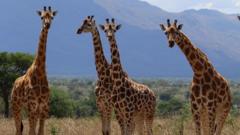In a significant update to our understanding of one of the animal kingdom's most beloved giants, researchers from the International Union for Conservation of Nature (IUCN) have officially classified the giraffe into four distinct species, rather than just one as previously believed. This landmark revision stems from a comprehensive study examining the genetic diversity, skull shape, and head structure of giraffes across Africa, uncovering enough variation to establish these species as separate entities.
The groundbreaking assessment sheds light on how geographical features such as rivers and mountains may have played crucial roles in the evolution of these long-necked mammals. The newly identified species include the Southern giraffe, residing in countries like Namibia and Botswana; the Reticulated giraffe, found in Kenya, Somalia, and Ethiopia; the Northern giraffe, spread across regions like western Ethiopia and Uganda; and the Masai giraffe, known for its distinctive skin pattern, inhabiting Kenya and Tanzania.
Among these, the Southern giraffe has been found to thrive in the southern African region where natural barriers like the Kunene and Zambezi rivers have kept it genetically isolated. The Reticulated giraffe also benefits from a distinct habitat in East Africa, while the Northern giraffe’s populations have adapted in territories divided by the Nile River and Lake Victoria.
Notably, the Masai giraffe, characterized by its unique leaf-patterned coat, has also been recognized as a separate species. Although initially assumed to be categorically distinct due to its coloration, ongoing research suggests that variations occur even among individuals within populations.
The IUCN emphasizes that this refined classification is crucial for conservation planning. The better we understand the taxonomy of giraffes, the more effectively we can assess their population status and formulate strategic conservation measures. Currently listed as vulnerable, this new classification may lead to a re-evaluation of the extinction risk facing these animals, allowing conservationists to employ targeted and effective strategies to salvage their numbers.
With the official acknowledgment of these four species, conservationists remain optimistic about the future of giraffes, advocating for action that not only protects their habitats but fosters their genetic diversity—ensuring that they thrive across the African landscape for generations to come.
The groundbreaking assessment sheds light on how geographical features such as rivers and mountains may have played crucial roles in the evolution of these long-necked mammals. The newly identified species include the Southern giraffe, residing in countries like Namibia and Botswana; the Reticulated giraffe, found in Kenya, Somalia, and Ethiopia; the Northern giraffe, spread across regions like western Ethiopia and Uganda; and the Masai giraffe, known for its distinctive skin pattern, inhabiting Kenya and Tanzania.
Among these, the Southern giraffe has been found to thrive in the southern African region where natural barriers like the Kunene and Zambezi rivers have kept it genetically isolated. The Reticulated giraffe also benefits from a distinct habitat in East Africa, while the Northern giraffe’s populations have adapted in territories divided by the Nile River and Lake Victoria.
Notably, the Masai giraffe, characterized by its unique leaf-patterned coat, has also been recognized as a separate species. Although initially assumed to be categorically distinct due to its coloration, ongoing research suggests that variations occur even among individuals within populations.
The IUCN emphasizes that this refined classification is crucial for conservation planning. The better we understand the taxonomy of giraffes, the more effectively we can assess their population status and formulate strategic conservation measures. Currently listed as vulnerable, this new classification may lead to a re-evaluation of the extinction risk facing these animals, allowing conservationists to employ targeted and effective strategies to salvage their numbers.
With the official acknowledgment of these four species, conservationists remain optimistic about the future of giraffes, advocating for action that not only protects their habitats but fosters their genetic diversity—ensuring that they thrive across the African landscape for generations to come.























